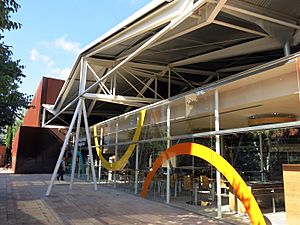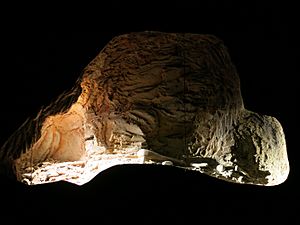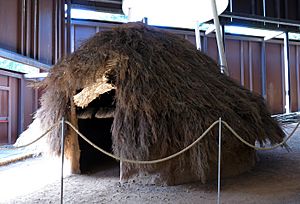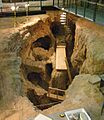Gavà Mines facts for kids
The Gavà Mines, also known as the Can Tintorer Mines, are an amazing archaeological site from the Neolithic period (a time in pre-history when people started farming). These ancient mines are located in the town of Gavà in Catalonia, Spain. Today, the Gavà Museum and the Gavà Mines Archaeological Park takes care of this special place.
These mines are some of the biggest and oldest in Europe. They cover a huge area of 200 hectares and include over a hundred known mines. Many more might still be hidden! What makes them extra special is that they are the only known Neolithic mines where people dug for a green mineral called variscite. This beautiful mineral was used to make cool body ornaments.
Later, during the times of the Iberians and the Roman Empire, and even into the Middle Ages, people reopened these mines to dig for iron ore.
Some of the most famous discoveries from this site are the Venus of Gavà statue and a special skull with ancient surgery marks.
Contents
Where are the Gavà Mines?
The Gavà Mines are found on the west side of the Llobregat River. They are at the bottom of the eastern part of the Garraf Massif mountains. This area is known as Ferreres, Rocabruna, and Tintorer.
The rocks here are very old, formed about 408 million years ago! They are mostly slates and limestones. These rocks are arranged in tilted layers with many bends and breaks.
How the Mines Were Discovered
The Gavà Mines were officially discovered in 1975. This happened when builders were working in the Can Tintorer area and found openings in the rock. However, local people had known about these "holes" in the ground for a very long time. They had even used some of them since ancient times!
In 1978, a group called CIPAG (Collective for the Investigation of Prehistory and Archeology of the Garraf-Ordal) started the first archaeological digs. The Gavà Museum was also created that year. Its job was to explore the site, study what was found, store the artifacts, and share the discoveries with everyone.
Until 1980, archaeologists dug up the mines they found. They also used machines to clear the ground and find new ones. In 1991, the Gavà Museum took over the excavations. Part of the museum opened to the public in 1993.
During these years, two very special items were found: the Venus of Gavà and the Trepanated Skull. Experts from the Universitat Politècnica de Catalunya also started working to preserve and restore the mines. Later, more research and conservation work was done by the University of Barcelona and the Autonomous University of Barcelona.
In 1998, a new part of the site was found in the Serra de les Ferreres area. This happened because of a city development project. Work continued there until 2009. New Neolithic and Iberian-Roman mines (numbers 83, 84, and 85) were found and dug up. These mines contained amazing burial items. Some of these included a red coral necklace, a plate made of obsidian (volcanic glass), square-shaped pottery, and honey-colored silex (flint).
When Were the Mines Used?
The Neolithic mines were used continuously for a long time. This was from the Advanced Old Neolithic period (also called Postcardial) to the Middle Neolithic. We know this from the types of pottery found. For example, there was pottery from the Molinot culture and the Ditch Tomb Culture.
Scientists used Carbon-14 dating to figure out the dates. They believe the Postcardial sites were used between 3350 and 2950 BCE (Before Common Era). The Middle Neolithic sites were used between 2950 and 2550 BCE. This means the mines were active roughly between 4200 BCE and 3400 BCE.
It's important to remember that these dates come from mining waste. So, the mines might have been used even earlier! For example, variscite from Gavà has been found in the Can Sadurní Cave with older dates. Also, variscite from Gavà was found in burials in Huesca province that date back to the 6th millennium BCE.
The dates for the Ibero-Roman mines are not as clear. However, it is thought they were used between the 4th and 9th centuries CE (Common Era).
Life in the Neolithic Period
Plants and Trees
During the Neolithic period, the people living at Gavà had many different types of plants around them. They could find plants in the mountains, on the plains, and near the coast.
Near the coast, there were many shrubs like the European fan palm, lentisk, heather, and juniper. There were also olive trees and Aleppo pine trees. Further inland, there were forests with oak trees, strawberry trees, and buckthorns. Along the rivers, there were forests with willows, poplars, and laurel trees. People used wood from some of these trees.
Food and Resources
Archaeologists found animal and plant remains, along with tools, in the mines. This shows that the mines were used for more than just digging. Tools like arrowheads, hand grinders, axe heads, and sickle teeth were found. These tools suggest that people were farming and raising animals.
People raised animals for food and other products like milk, wool, and leather. They mainly raised cattle, sheep, and goats, and some pigs. They also hunted animals like deer, wild boar, and rabbits. Fishing was also important, and they caught fish like seabream and cuttlefish. They collected shellfish like mussels and limpets for food and for making ornaments. Even land snails were part of their diet!
The main crops they grew were barley and some wheat. They also grew legumes like vetches. In addition to farming, they gathered wild plants. These included olives, wild grapes, and hazelnuts.
Tools and Pottery
The people of Gavà during the Neolithic period used tools made from bone and stone. Some stone tools were chipped, like flint and obsidian blades. Others were polished. They also made ceramic pots from local clay. These pots were usually baked over open fires. Some special pottery found in graves included wide-mouthed pots with holes for hanging, and rectangular box-like bowls.
Burials and Beliefs
Once a mine was no longer useful for digging, some were reused as tombs. These burial sites contain the remains of men, women, and children of all ages.
Some bodies were placed together in shared graves near the mine entrance. The bodies were often placed in a curled-up position, like a baby in a womb. They were buried with special items, called funerary offerings, such as pottery, tools, and ornaments. Sometimes, olive tree branches were burned.
Individual burials, or burials with just two people, were often more elaborate. These were found in small rooms deep inside the mine, away from the entrance. The burial space was sealed with stone slabs. The mine entrance was also closed off with large stones.
Studying the burials tells us a lot about the Neolithic community. People lived to about 30 years old on average. Men were about 164 cm (5 feet 4 inches) tall, and women were about 151 cm (4 feet 11 inches) tall. Some bones show signs of hard work, suggesting that both men and women worked in the mines. This might mean that people had specialized jobs.
The differences in how people were buried might show that there were social differences in their society. The burials also show that they had some medical knowledge. For example, some bones had healed fractures. One person even survived two skull surgeries!
The fact that variscite was found with burials suggests it had a special meaning. Burying the dead in the mines also seems important. Some experts think the green color of variscite symbolized life. The curled-up body positions and the offerings might show a belief in rebirth and a connection to the Earth.
The community also had strong religious beliefs. This is shown by figurines like the Venus of Gavà, which might have been a fertility goddess. Another interesting find, possibly with religious meaning, was a large collection of artifacts in mine 85. These included bone tools, arrowheads, variscite beads, and more.
Mine Structures
The Neolithic mines were very different in size and shape. Here are a couple of examples:
Mine 83
Mine 83 was dug between 1999 and 2003. To get in, you went down a vertical shaft about 1 meter wide and 1.5 meters deep. At the bottom, two tunnels branched off. One was straight and 2 meters long. The other was bent at a right angle, 4 meters long, and went down another 1.5 meters.
After the mine was no longer used for digging, it was empty for a long time. Then, a burial chamber was dug off the bent tunnel. It was about 1.5 by 2 meters and held one or more bodies. The mine was then sealed. The burial chamber was closed with two limestone slabs. The entrances of the tunnels were blocked with soil and stones. The main entrance shaft was blocked with a huge, egg-shaped boulder.
Radiocarbon dating shows that the mine was dug before 4050 BCE and closed after that time.
Inside the burial chamber, archaeologists found a rectangular ceramic bowl. It had traces of fat, suggesting it held lard or tallow. They also found stone axe heads, a bone tool, flint blades, and an obsidian blade from Sardinia. There were also variscite pieces and two necklaces. One necklace was made of variscite beads, and the other was made of red coral. The bones found were from one adult, but they were very broken. The skull was missing.
Mine 84
Mine 84 was also dug between 1999 and 2003. This mine has a very complex shape and history! The first entrance was a vertical shaft about 1.5 meters deep. From there, a straight tunnel about 10 meters long sloped downwards. There was also a second entrance shaft. The tunnel ended in a room about 3 meters wide and 3 meters tall. From this room, three other tunnels branched off. Most of the tunnels were roundish and about 1 to 1.5 meters wide.
The tunnels still show signs of mining activity. You can see marks from pickaxes on the walls. There are also small niches where lamps were probably placed.
After the mine was no longer used for digging, it became a burial site. Two people were buried at the end of one of the tunnels, at different times. They had many grave offerings. The entrances to the tunnels were closed off with limestone slabs, stone blocks, and soil. These closures seemed temporary, perhaps to allow for more burials later. Radiocarbon dating suggests the mine was used and both burials happened within a few decades, around 3900 and 3750 BCE.
The bones found were very broken. They had been placed on the mine floor without being buried in the ground. Animals and water had also affected them. The bones of the first person, an adult man, were scattered. They seemed to have been moved to make space for the second person, a taller adult woman. The few teeth that remained were very worn down, suggesting a rough diet or that they were used as tools. The faces of both individuals were missing. The man's skull also showed signs of two healed blows. The woman's bones showed signs of heavy labor, especially in her right arm, and of carrying heavy loads on her head.
The offerings found with the burials included two ceramic urns, a rectangular ceramic bowl, bone tools, an ox bone, a Glycymeris shell, flint blades, and some boar tusks.
See also
 In Spanish: Minas prehistóricas de Gavá-Can Tintorer para niños
In Spanish: Minas prehistóricas de Gavá-Can Tintorer para niños
Images for kids






